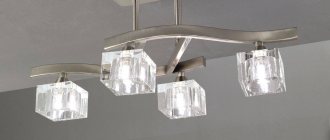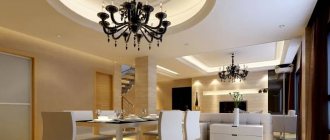In the interior of the living room, the chandelier occupies a special place. This is not just a lighting device, but the finishing touch to the design. Therefore, it is important to find the right product. In this article we will tell you how to choose a chandelier for a spacious hall or a modest living room. Let's consider all aspects: both technical characteristics and appearance, suitable for a certain style. We will also look at the designers' recommendations.
Chandelier dimensions: height, depth, width
When buying a chandelier, you will be faced with its dimensional characteristics: height, depth, width (diameter). There are nuances to these designations. For example, some manufacturers designate the maximum and minimum height of a chandelier, and the width is called the diameter.
- Max. the height of the lamp/chandelier is the distance from the mounting point on the ceiling to the bottom of the structure, i.e. with a leg, chain, etc.;
- Min. The height of the chandelier is the height of the structure without the leg, chain and mounting bowl. This variation in height indicates that the “leg” of the chandelier is adjustable in height. If the length is indicated without a step, then most likely the leg is not adjustable;
Maximum and minimum height of the chandelier
Width and diameter of the chandelier
- The width of a chandelier is often referred to as its diameter;
- There are also nuances with the depth of the chandelier. For example, the width and depth of a symmetrical chandelier are equal, but an asymmetrical one is different.
Asymmetrical chandelier
Symmetrical chandelier
Criteria for choosing a modern chandelier
In addition to its main functional component - lighting a space, a chandelier can perform other options - zoning a room, visually making it more spacious and voluminous due to correctly selected lighting intensity and distribution of light fluxes, it can create the necessary accent, become a central element of the interior, and distract attention from unsuccessful objects or entire areas.
So, the choice of chandelier is influenced by the following criteria:
- purpose of the room - it is obvious that a chandelier for a bathroom and a living room, for example, must be chosen differently;
- the size of the room and the number of functional zones, the presence of other lighting fixtures - even in small rooms, the lighting system rarely consists of one pendant lamp, given the multifunctionality of the premises, each segment requires its own source of artificial light;
- the color palette of the interior influences the choice of chandelier design, its power and lighting color (warm or cold flow);
- the stylistic direction in interior design directly influences the choice of chandelier model;
- the financial capabilities of the owners of the room for which the lamp is being selected and their idea of the beauty and practicality of lighting fixtures - the range in cost of modern chandeliers is incredibly wide.
Chandelier height and ceiling height
To determine the allowable height of a chandelier for your living room, use the max. height of the chandelier. Remember that the length of the chain can be adjusted, but the stationary leg cannot be made smaller. Therefore, double check the dimensions.
After hanging the chandelier, the remaining height is the distance from the bottom of the structure to the floor.
As a standard, 190 cm from the bottom of the chandelier to the floor is considered comfortable. The formula is this: ceiling height - 190 cm = maximum length of the chandelier. This way, you won’t hit the top of your head on the chandelier or accidentally knock it over with your hand.
How to calculate the height of a chandelier. Scheme
Another way to calculate the allowable length of a chandelier is to focus on the height of the doorway, which is approximately 2 meters. That is, choose a chandelier no lower than the top of the doorway.
But it’s better not to trust formulas and standard values, but to try on a chandelier for yourself, taking into account personal preferences, the height of the tallest family member, the area and height of the ceilings, etc.
IMPORTANT: A chandelier cannot be a single light source; complement the functional areas with sconces, floor lamps, accent lamps, etc.
190 cm or the height of the doorway - exactly this amount of free ceiling height should remain after installing the chandelier.
Low ceilings - below 2.5 m
The standard ceiling height in residential premises, according to SNIP requirements, must be no lower than 2.5 m. If the ceilings are 2.5 m or lower (for example, due to incorrectly calculated hanging structures), then take a closer look at multi-lamp ceiling chandeliers - for a large living room . Or single-lamp lamps for a small room. They are attached without a “leg” and eat up only 5 to 35 cm of the ceiling height.
IMPORTANT: Select the light in the room according to the furniture arrangement plan, taking into account all sizes. The diagram will immediately show what you are dealing with and which segment of chandeliers you should not waste time on.
Ceiling chandelier in a small living room with a low ceiling
High ceilings - more than 3 m
For high ceilings, classic multi-lamp chandeliers on a leg, from 60 cm and above, are suitable. As well as designer asymmetrical designs.
IMPORTANT: remember, high ceilings “eat up” the light, so the power of the light bulbs is increased by 1.5 times the recommended standard power. More about this below.
Designer asymmetrical chandelier in a large living room with a high ceiling
Peculiarities
A stylish, beautiful chandelier is undoubtedly the dream of many. However, low ceilings significantly narrow the choice.
When installing a lighting system, you should act with extreme caution, since if you do not know some design rules, you can make the room gloomy, depressive and mundane.
Experienced designers give some simple recommendations.
- Extended pendants are not suitable in this case; the closer the panel with lamps is to the ceiling, the better, only then will the light fully illuminate the living room. To enhance the desired effect, choose stretch fabrics and paints with a reflective effect.
- Buy a chandelier that will be fixed directly to the ceiling, in this way you will save space.
- If possible, combine different lighting sources in the room - it is advisable to complement the central chandelier with wall sconces; as an alternative, you can install lighting along the entire perimeter of the plasterboard box. In combination with the main lamp, such a solution will be quite effective.
If desired, you can make parallel lighting on the floor - this technique will allow you to extend the length.
- Give preference to spotlights evenly distributed throughout the room - this option is not only additional, but often the main one, while an abundance of small lamps can easily replace a chandelier.
- Avoid models with shades of dark colors; preference should be given to equipment that can transmit light in all directions.
The power of the chandelier in the living room and the number of light bulbs
Formula for calculating the power of a chandelier
The power of the chandelier affects the level of illumination in the room. To calculate the comfortable level of illumination in the living room, you need two values: the area of the room, the height of the ceiling and the required number of W per square meter (SNiP 23-05-95). The living room is a multifunctional room, so the standard value of W per square meter is greater than in the bathroom or bedroom - 20 W (a unit of electric current power).
Chandelier power = room area * standard value W per square meter (in the living room - 20 W).
The ceiling height in this formula is only important when the ceilings are higher than 3 meters. Since high ceilings eat up light, the resulting figure must be multiplied by 1.5.
In practice, it looks like this: a living room with an area of 20 m2 and a ceiling height of 3.5 m. That is, (20 * 20) * 1.5 = 600 W - it will be needed to illuminate the living room without creating dark corners.
From here, it becomes clear that a chandelier with 6 shades for incandescent lamps with a power of 100W, or 10 incandescent lamps of 60W each, is suitable for this particular living room. Or combine several lighting fixtures (chandelier, floor lamp, etc.) so that in total they create 600 W.
IMPORTANT: Select the power of the light bulbs according to the capabilities of the chandelier. This information is indicated in the product characteristics or is known to the consultant.
Ceiling chandelier in a gray living room with a suspended ceiling
Type of light bulbs in a chandelier
The calculation of the number of lamps also depends on the type of lamps: incandescent lamps, halogen lamps, energy-saving fluorescent lamps or LED lamps.
- Thus, a 40 W halogen lamp is identical to a conventional 60 W incandescent lamp. That is, a halogen lamp gives approximately 1.5 times more light than an incandescent lamp.
This means that in the living room you will need power not 600 W, but 400 W.
- A fluorescent lamp produces approximately five times more light than an incandescent lamp. That is, you will need not 600 W, but 120 W.
IMPORTANT: Remember that the lampshade material can eat up the light output. For example, a lampshade made of dark, light-blocking material reduces the level of illumination. Therefore, it is better to select light bulbs for a new chandelier for the first time in the store.
As for chandeliers with LED bulbs, compared to fluorescent options, LEDs are 50% more economical. And if you use them instead of incandescent lamps, you can reduce costs by 95%.
Types of light bulbs for chandeliers, their characteristics and differences diagram
Types of lamps can be combined with each other. For example, for a chandelier of 3-4 arms on a suspended ceiling, fluorescent lamps (they do not heat up) or LED are suitable, for a wall sconce a halogen lamp and an incandescent lamp for a floor lamp.
IMPORTANT: When choosing lamps, it is important to pay attention to the sockets and their material. It is better to buy universal ones - E27, E14. For others, it is difficult to find replacement light bulbs. The material must also withstand high temperatures. Thermoplastic or ceramic will do.
E27 light bulb socket
E14 light bulb socket.
- Define power
- Select a chandelier/floor lamps/sconces, etc.
- Divide the power among all lighting fixtures
- Select the type of light bulbs, taking into account the permissible power of each device
- Check the color of the light bulb immediately in the store
Shapes and sizes
The size of the ceiling chandelier will depend on the size of the room: it may have low ceilings, but a lot of space around it. In this case, wide lamps with small additional elements or patterns would be appropriate.
If the room has not only low ceilings, but also a small area, a compact attribute will be the best option. In addition to the size of the lampshades, it is also necessary to take into account their shape.
The shape of the lampshade plays an important role: a chandelier with a wide and elongated lampshade will lower the ceiling even more, while a narrow and long lampshade will give a different visual effect - everything will depend on where it is attached. Thus, a profitable option would be a pressed ceiling chandelier without additional decor or a strict elongated lamp with a mirror effect or metallic color.
Chandelier and ceiling type: safety precautions
Concrete ceiling - for any chandelier.
Stretch ceiling - check the type of light bulbs.
Plasterboard ceiling - use lightweight ceiling chandeliers.
Concrete ceiling in the living room
Ideally, it is better to attach any chandelier (pendant and ceiling) to a concrete floor slab. It's safer this way. You can safely attach a classic long chandelier made of glass and crystal to such a ceiling, the main thing is that the total area of the living room allows it.
Chandelier in the loft living room on a concrete ceiling
Stretch ceiling in the living room
The most important thing to remember about a chandelier on a suspended ceiling is the type of lamps used in it. Only LED and fluorescent lamps are suitable for such a ceiling, but incorrectly selected incandescent and halogen lamps can cause a fire. It is important to limit the power with them: halogen - no more than 35 W, incandescent - 40 W. The minimum distance from the canvas to the light bulbs is also important - 20 cm. The lampshades should face down or to the sides. If the horns point upward, there should be at least 40 cm to the ceiling.
Chandelier in the loft living room on a suspended ceiling
Look how perfectly a classic crystal chandelier fits into a loft interior.
Plasterboard ceiling in the living room
If the light installation is on plasterboard, then remember that plasterboard ceilings do not like heavy hanging chandeliers. Structures larger than 5 kg are not recommended. However, there are special lightweight ceiling chandeliers for such cases.
Chandelier in the loft living room on a plasterboard ceiling
Suitable options
Let's take a closer look at the various options for chandeliers that can be used to decorate a room with low ceilings:
- On the bar. These products may differ in the number and direction of the rods, as well as the length of the center console. This design ensures bright lighting. It is advisable to choose chandeliers whose shades are directed up, down and to the sides.
- Cascade chandeliers. Products are allowed in rooms with low ceilings only if the length of the hanging parts is short, the design contains many light elements, and the panel itself is wide. The models are compact and therefore do not overload the space.
- Crystal. These are luxurious and rich chandeliers that invariably give the room an expensive look. This option is optimal for living rooms decorated in baroque, rococo or classic style. It is advisable to have as many light bulbs as possible - then the reflected light will create a beneficial lighting effect in the room.
However, try to purchase a similar model that does not hang too far from the ceiling.
- Horn chandeliers. Such designs can be used when the suspended part is low and the lampshades are located as close to the ceiling as possible. When buying a chandelier, you should choose models that diffuse light efficiently and are optimally open.
LED models in high-tech interiors can have the most intricate configurations; they take up very little space, but at the same time become a real decoration of the room.
A win-win option would be flat ceiling lamps, which are placed almost under the ceiling. As a rule, they look like a large light element made of translucent material, with 2 to 8 light bulbs underneath it.
The only drawback of such lamps is the simplicity of the design, so this solution is suitable only for ultra-modern styles (minimalism or hi-tech).
Chandelier in the living room: selecting it to match the interior
Chandelier in the living room with dark furniture
Dark furniture and a generally dark living room interior will reflect light worse than light surfaces. Therefore, it is better to choose a chandelier with a large number of shades (if the area allows). or complement a small chandelier with sconces, floor lamps, etc. From a decorative and practical point of view, a chandelier made of glass, crystal and metal parts is well suited to a dark living room. This model transmits and/or reflects daylight and artificial light.
TIP: In a large living room, lampshades looking down provide accent light, which is not enough for a spacious living room. And the horns directed to the sides and upwards, on the contrary, create general diffused lighting.
Classic pendant chandelier in a dark living room
Classic pendant chandelier in a dark living room
Chandelier in the living room with light furniture
In bright living rooms, a chandelier can support an overall calm palette or, conversely, be a bright element.
TIP: A chandelier with shades facing the walls expands the space. Therefore, they are perfect for small living rooms.
Classic pendant chandelier in a bright Scandinavian living room
Chandelier with shades pointing upward in a bright living room
Materials for ceiling lamps
Structurally, ceiling lighting fixtures consist of suspended fittings and lampshades with decor.
Lampshades and pendants can be made from:
- Glass;
- Plastics;
- Crystal;
- Ceramics;
- Porcelain;
- Fabrics.
Crystal and glass have high light reflectivity. Plastic can be used to make lampshades and decor of almost any shape.
Chandelier fittings are most often made of metal. It has good strength and excellent ductility, which makes it possible to make chandeliers of various shapes.
Mainly used:
- Painted steel;
- Stainless steel;
- Aluminum;
- Brass;
- Bronze.
For designer models, various types of wood, precious metals and stones are often used.
Crystal chandeliers for low rooms are a very good choice. They are produced in small dimensions, but the ability of crystal to refract and magnify light makes it possible to provide excellent illumination of the room. In addition, the aesthetic component of such lamps plays a significant role.











